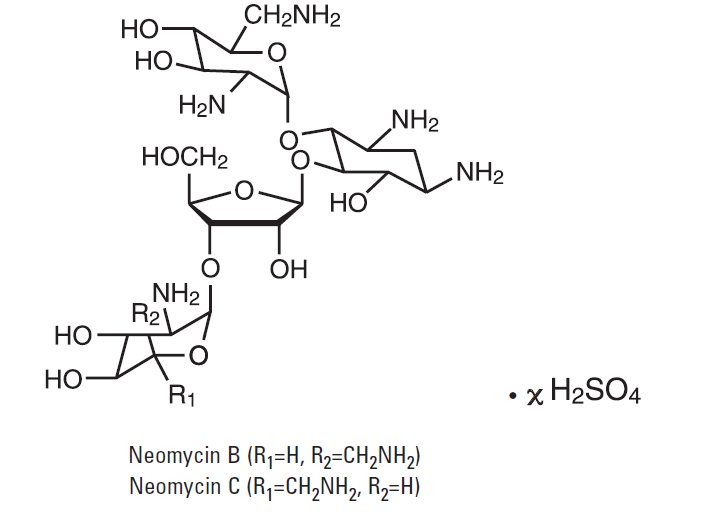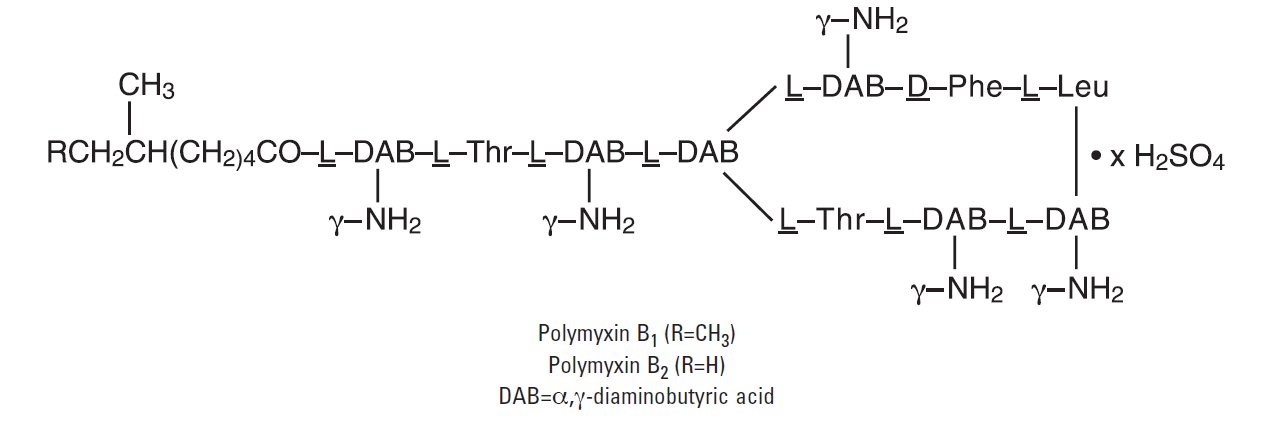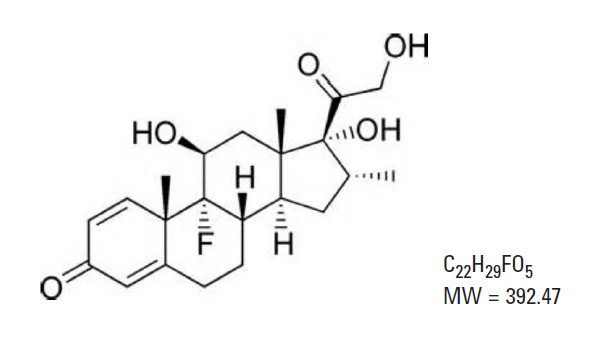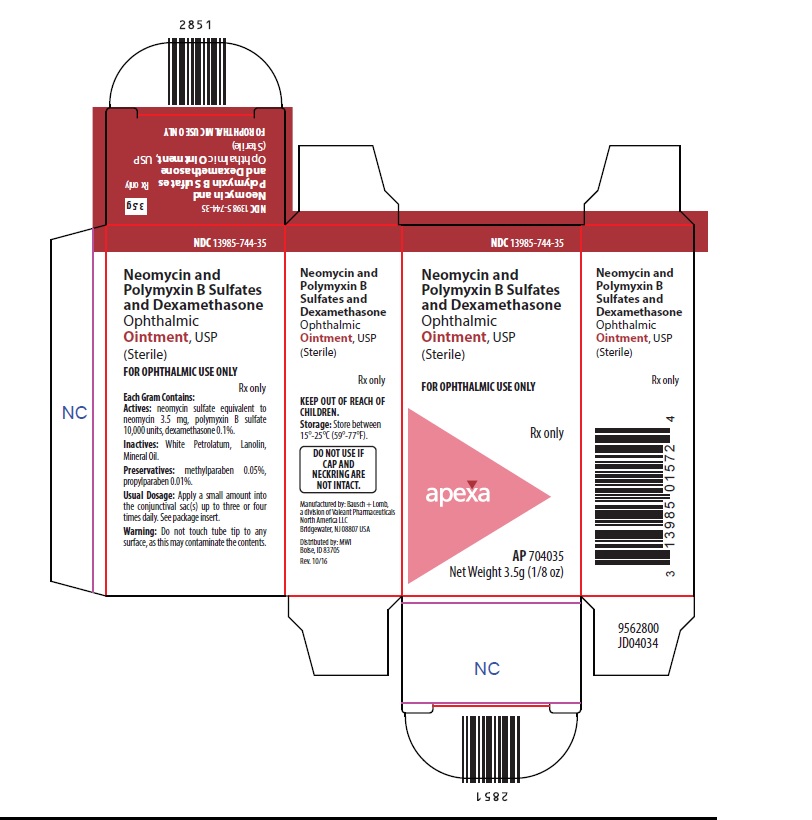Label: NEOMYCIN AND POLYMYXIN B SULFATES AND DEXAMETHASONE- neomycin sulfate, polymyxin b sulfate, and dexamethasone ointment
-
Contains inactivated NDC Code(s)
NDC Code(s): 13985-744-35 - Packager: MWI
- Category: HUMAN PRESCRIPTION DRUG LABEL
- DEA Schedule: None
- Marketing Status: Abbreviated New Drug Application
Drug Label Information
Updated October 26, 2016
If you are a consumer or patient please visit this version.
- Download DRUG LABEL INFO: PDF XML
- Official Label (Printer Friendly)
- SPL UNCLASSIFIED SECTION
-
DESCRIPTION
Neomycin and Polymyxin B Sulfates and Dexamethasone Ophthalmic Ointment, USP is a multiple dose anti-infective steroid combination in sterile ointment form for topical application.
The chemical structure for the active ingredient, Neomycin Sulfate is:
The chemical structure for the active ingredient Polymyxin B Sulfate is:
The chemical structure for the active ingredient Dexamethasone is:
Established Name:
Dexamethasone
Chemical Name: Pregna-1,4-diene-3,20-dione,9-fluoro-11,17,21-trihydroxy-16-methyl-,(11β, 16α)-Each gram contains: Active: neomycin sulfate equivalent to neomycin 3.5 mg, polymyxin B sulfate 10,000 units, dexamethasone 0.1%. Preservatives: methylparaben 0.05%, propylparaben 0.01%. Inactives: White Petrolatum, Lanolin, Mineral Oil.
-
CLINICAL PHARMACOLOGY
Corticoids suppress the inflammatory response to a variety of agents and they probably delay or slow healing. Since corticoids may inhibit the body's defense mechanism against infection, a concomitant antimicrobial drug may be used when this inhibition is considered to be clinically significant in a particular case.
When a decision to administer both a corticoid and an antimicrobial is made, the administration of such drugs in combination has the advantage of greater patient compliance and convenience, with the added assurance that the appropriate dosage of both drugs is administered, plus assured compatibility of ingredients when both types of drugs are in the same formulation and, particularly, that the correct volume of drug is delivered and retained.
The relative potency of corticosteroids depends on the molecular structure, concentration and release from the vehicle.
-
INDICATIONS AND USAGE
For steroid-responsive inflammatory ocular conditions for which a corticosteroid is indicated and where bacterial infection or a risk of bacterial ocular infection exists.
Ocular steroids are indicated in inflammatory conditions of the palpebral and bulbar conjunctiva, cornea, and anterior segment of the globe where the inherent risk of steroid use in certain infective conjunctivitides is accepted to obtain a diminution in edema and inflammation. They are also indicated in chronic anterior uveitis and corneal injury from chemical, radiation or thermal burns; or penetration of foreign bodies.
The use of a combination drug with an anti-infective component is indicated where the risk of infection is high or where there is an expectation that potentially dangerous numbers of bacteria will be present in the eye.
The particular anti-infective drug in this product is active against the following common bacterial eye pathogens: Staphylococcus aureus, Escherichia coli, Haemophilus influenzae, Klebsiella/Enterobacter species, Neisseria species, and Pseudomonas aeruginosa.
This product does not provide adequate coverage against: Serratia marcescens and Streptococci, including Streptococcus pneumoniae.
-
CONTRAINDICATIONS
Epithelial herpes simplex keratitis (dendritic keratitis), vaccinia, varicella, and many other viral diseases of the cornea and conjunctiva. Mycobacterial infection of the eye. Fungal diseases of ocular structures. Hypersensitivity to a component of the medication. (Hypersensitivity to the antibiotic component occurs at a higher rate than for other components.)
-
WARNINGS
NOT FOR INJECTION. Do not touch tube tip to any surface, as this may contaminate the contents. Prolonged use may result in glaucoma, with damage to the optic nerve, defects in visual acuity and fields of vision, and posterior subcapsular cataract formation. Prolonged use may suppress the host response and thus increase the hazard of secondary ocular infections. In those diseases causing thinning of the cornea or sclera, perforations have been known to occur with the use of topical steroids. In acute purulent conditions of the eye, steroids may mask infection or enhance existing infection. If this product is used for 10 days or longer, intraocular pressure should be routinely monitored even though it may be difficult in children and uncooperative patients.
Products containing neomycin sulfate may cause cutaneous sensitization.
Employment of steroid medication in the treatment of herpes simplex requires great caution.
-
PRECAUTIONS
The initial prescription and renewal of the medication order beyond 8 grams should be made by a physician only after examination of the patient with the aid of magnification, such as a slit lamp biomicroscopy and, where appropriate, fluorescein staining.
The possibility of persistent fungal infections of the cornea should be considered after prolonged steroid dosing.
Patients should be advised not to wear contact lenses if they have signs and symptoms of bacterial ocular infection.
Pregnancy:
Pregnancy Category C. Dexamethasone has been shown to be teratogenic in mice and rabbits following topical ophthalmic application in multiples of the therapeutic dose.
In the mouse, corticosteroids produce fetal resorptions and a specific abnormality, cleft palate. In the rabbit, corticosteroids have produced fetal resorptions and multiple abnormalities involving the head, ears, limbs, palate, etc.
There are no adequate or well-controlled studies in pregnant women. Neomycin and Polymyxin B Sulfates and Dexamethasone Ophthalmic Ointment should be used during pregnancy only if the potential benefit to the mother justifies the potential risk to the embryo or fetus. Infants born of mothers who have received substantial doses of corticosteroids during pregnancy should be observed carefully for signs of hypoadrenalism.
Nursing Mothers:
Systemically administered corticosteroids appear in human milk and could suppress growth, interfere with endogenous corticosteroid production, or cause other untoward effects. It is not known whether topical administration of corticosteroids could result in sufficient systemic absorption to produce detectable quantities in human milk. Because many drugs are excreted in human milk, caution should be exercised when Neomycin and Polymyxin B Sulfates and Dexamethasone Ophthalmic Ointment is administered to a nursing woman.
-
ADVERSE REACTIONS
Adverse reactions have occurred with steroid/anti-infective combination drugs which can be attributed to the steroid component, the anti-infective component, or the combination. Exact incidence figures are not available since no denominator of treated patients is available.
Reactions occurring most often from the presence of the anti-infective ingredients are allergic sensitizations. The reactions due to the steroid component are: elevation of intraocular pressure (IOP) with possible development of glaucoma and infrequent optic nerve damage; posterior subcapsular cataract formation; and delayed wound healing.
Secondary Infection: The development of secondary infection has occurred after use of combinations containing steroids and antimicrobials. Fungal infections of the cornea are particularly prone to develop coincidentally with long-term applications of steroid. The possibility of fungal invasion must be considered in any persistent corneal ulceration where steroid treatment has been used. Secondary bacterial ocular infection following suppression of host responses also occurs.
To report SUSPECTED ADVERSE REACTIONS, contact Bausch + Lomb, a division of Valeant Pharmaceuticals North America LLC, at 1-800-321-4576 or FDA at 1-800-FDA-1088 or www.fda.gov/medwatch.
-
DOSAGE AND ADMINISTRATION
Apply a small amount into the conjunctival sac(s) up to three or four times daily.
How to apply Neomycin and Polymyxin B Sulfates and Dexamethasone Ophthalmic Ointment:
1. Tilt your head back.
2. Place a finger on your cheek just under your eye and gently pull down until a "V" pocket is formed between your eyeball and your lower lid.
3. Place a small amount (about 1/2 inch) of Neomycin and Polymyxin B Sulfates and Dexamethasone Ophthalmic Ointment in the "V" pocket. Do not let the tip of the tube touch your eye.
4. Look downward before closing your eye.
Not more than 8 grams should be prescribed initially and the prescription should not be refilled without further evaluation as outlined in PRECAUTIONS above.
-
HOW SUPPLIED
Neomycin and Polymyxin B Sulfates and Dexamethasone Ophthalmic Ointment, USP is supplied in an ophthalmic tube in the following size:
NDC 13985-744-35 – 3.5 g tube
Storage:
Store between 15°-25°C (59°-77°F).
KEEP OUT OF REACH OF CHILDREN.
DO NOT USE IF CAP AND NECKRING ARE NOT INTACT.
FOR OPHTHALMIC USE ONLY
Revised 10/2016
Manufactured by:
Bausch + Lomb, a division of
Valeant Pharmaceuticals North America LLC
Bridgewater, NJ 08807 USA
Distributed by: MWI
Boise, ID 83705956300 (Flat)
9564000 (Folded)
- Principal Display Panel
-
INGREDIENTS AND APPEARANCE
NEOMYCIN AND POLYMYXIN B SULFATES AND DEXAMETHASONE
neomycin sulfate, polymyxin b sulfate, and dexamethasone ointmentProduct Information Product Type HUMAN PRESCRIPTION DRUG Item Code (Source) NDC:13985-744 Route of Administration OPHTHALMIC Active Ingredient/Active Moiety Ingredient Name Basis of Strength Strength NEOMYCIN SULFATE (UNII: 057Y626693) (NEOMYCIN - UNII:I16QD7X297) NEOMYCIN 3.5 mg in 1 g POLYMYXIN B SULFATE (UNII: 19371312D4) (POLYMYXIN B - UNII:J2VZ07J96K) POLYMYXIN B 10000 [USP'U] in 1 g DEXAMETHASONE (UNII: 7S5I7G3JQL) (DEXAMETHASONE - UNII:7S5I7G3JQL) DEXAMETHASONE 1 mg in 1 g Inactive Ingredients Ingredient Name Strength LANOLIN (UNII: 7EV65EAW6H) METHYLPARABEN (UNII: A2I8C7HI9T) MINERAL OIL (UNII: T5L8T28FGP) PROPYLPARABEN (UNII: Z8IX2SC1OH) PETROLATUM (UNII: 4T6H12BN9U) Packaging # Item Code Package Description Marketing Start Date Marketing End Date 1 NDC:13985-744-35 1 in 1 CARTON 07/25/1994 1 3.5 g in 1 TUBE; Type 0: Not a Combination Product Marketing Information Marketing Category Application Number or Monograph Citation Marketing Start Date Marketing End Date ANDA ANDA064063 07/25/1994 Labeler - MWI (019926120) Establishment Name Address ID/FEI Business Operations Bausch & Lomb Incorporated 079587625 MANUFACTURE(13985-744)





